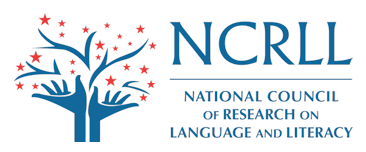Considering What Families Bring
to Literacy Learning:
What We Know and Why It Matters
This post was written by member Jane Bean-Folkes.
 At NCTE 2018, the National Council for Research on Language and Literacy (NCRLL) hosted a panel session, Considering What Families Bring to Literacy Learning: What We Know and Why it Matters featuring senior and junior scholars that addressed The National Council of Teachers of English (NCTE) fall conference. This panel presentation featured two established scholars who have recently been awarded the NCRLL Distinguished Scholar Award: Patricia Edwards, of Michigan State University and Peter Smagorinsky, University of Georgia. These esteemed colleagues were joined by Jaime Puccioni of Albany University and Tisha Lewis Ellison, University of Georgia two emerging voices in the literacy field. The members of the panel explored how parents and family members contribute to children’s emergent literacy knowledge and experiences.
At NCTE 2018, the National Council for Research on Language and Literacy (NCRLL) hosted a panel session, Considering What Families Bring to Literacy Learning: What We Know and Why it Matters featuring senior and junior scholars that addressed The National Council of Teachers of English (NCTE) fall conference. This panel presentation featured two established scholars who have recently been awarded the NCRLL Distinguished Scholar Award: Patricia Edwards, of Michigan State University and Peter Smagorinsky, University of Georgia. These esteemed colleagues were joined by Jaime Puccioni of Albany University and Tisha Lewis Ellison, University of Georgia two emerging voices in the literacy field. The members of the panel explored how parents and family members contribute to children’s emergent literacy knowledge and experiences.
Dr. Puccioni: Examining the Associations among Preschool Teachers’ Outreach Efforts, Parental Involvement, and Children’s Reading Achievement
Puccioni opened the session by drawing on a theory of parental involvement proposed by Hoover-Dempsey and colleagues (2005). Her work draws on her experience as a sixth-grade teacher and mother. This work suggested that the invitations extended by educators shape parents’ school and home-based involvement, which in turn, influences children’s outcomes. Using nationally representative data from the Early Childhood Longitudinal Study – Birth cohort (N ≈ 3,200), a structural equation model was estimated to examine relationships among preschool teachers’ outreach efforts, parental involvement, and children’s reading achievement during the transition to elementary school. Puccioni’s results indicate that parent’s perceptions of preschool teachers’ outreach efforts are positively associated with home-based parental involvement, which in turn, is positively associated with children’s reading achievement in kindergarten. More specifically, the findings suggest that parents who have more positive perceptions about preschool teachers’ outreach efforts report engaging in more home-based involvement practices, which in turn, has a positive impact on children’s early reading achievement. These findings have important practical implications for educators who aim to encourage parental involvement that supports children’s early literacy development.
Dr. Edwards: Connecting Home and School Literacies in the Classroom: An Intervention Study
Connecting home and school literacies in the classroom are critical to improving the educational outcomes for all children. Edwards shared how a design experiment methodology was employed to focus on relevant factors for the successful use of parent stories as a space for shaping teachers’ perceptions about students’ home language and literacy experiences and teachers’ enactment of these perceptions within literacy planning and instruction. Edwards shared how the analysis of the data resulted in four central findings. First, the elementary teacher participants experienced intense pressure to implement basal curricula with fidelity. Second, participants experienced tension between complying with their district’s mandated use of basal curricula and enacting pedagogical practices that built upon students’ home literacies. Third, the parent stories model provided a space for teacher participants to engage in meaningful conversations with parents so that they could adapt basal curricula to incorporate students’ home literacies. Fourth, participants altered how they described when they taught literacy, moving from constrained instructional times to an integrated literacy model.
Dr. Lewis-Ellison: Supporting Literacy Learning at Home between an African American Father with his Children
While the first two talks focused on classroom practice, Lewis Ellison talked about the importance of the spaces in which learning occurs. She highlighted that creativity, choice, imagination, and agency relate to how students view their worlds and experiences. One way to explore student learning, and more specifically African American student learning, she stated was to consider literacy experiences that occur among family members. Examining literacy learning, within the context of African American youth and families, is significant when imagining ways to challenge cultural-deficit viewpoints that have dominated research concerning their rich and complex literacy practices. Using critical sociocultural theory to focus on the literacy practices with attention to identity, power, and agency, and photo-elicitation as a visual and multimodal research method to use photos to evoke memories and feelings about an activity, this presentation examines how an African American father and his children used a do-it-yourself video to create Christmas ball lights and the effects this project had on their learning together. Lewis Ellison indicated when educators recognize the educational value that rests in home literacy practices of youth and their parents, we can consider possibilities for improving African American students’ literacy outcomes, inform practices and programs, create rigor in research, and transform polices. Lewis Ellison’s talk highlighted an aspect of why this study is so important? She illuminated the reality that African American fathers are seldom looked at in a positive light due to the negative social and media attention. Engagement between African American fathers and their families have a significant impact on literacy practices.
Dr. Smagorinsky: The Community Context for Literacies and their Practice: Mural Art in Guadalajara as First Literacies
Smagorinsky made a case for an image as a literacy narrative from his experiences in Guadalajaran. The exploration and analysis of cultural images of Guadalajaran mural culture provided the foundation for literacy. His presentation highlighted the “First Literacies” that many children bring to formal literacy learning, i.e., multimodal literacies produced through material, rather than digital, means. This term was developed by the speaker to account for the ways in which graphic images provided the first means of telling stories, representing culture, and providing historical icons for continuity across generations, beginning with cave wall drawings from 40,000 years ago, extending through both European and Aztec cultures, and still vital in mural and other artistic forms in Mesoamerica, the US, and other societies that use material means for expressive purposes. Smagorinsky’s work with the University of Guadalajara and street excursions in the city provide the basis for the talk, historicized with attention to the role of multimodal material texts historically and in the present.
Conclusion
Overall, the presentations prompted participants of the need to rethink ways in which to shift literacy discourse between families and schools to strengthen the sociocultural practices regarding literacy and power. The work of literacy occurs in different contexts and periods. The presenters made implications for the importance of building a reciprocal nature with teachers, parents, and schools working together to impact children’s early reading achievement. Also, Edwards questioned, is teaching a profession, an art or a science? It is all three! She stated, because teaching is an art, we need to learn how to collect data. The importance of why teacher’s need to collect data has implications for classroom practice. Why? In order to see how parent stories can help teachers to develop a human side of learning and communicating as literacy providers, how they impact students views of school and the impact of school. Researchers on the panel emphasized helping teachers to be teacher researchers of literacy to inform the practice of English language development versus research that goes nowhere. Thus, as researchers, we must be open to how children bring their knowledge of literacy to formal literacy environment.
 Jane Bean-Folkes is an assistant professor in the Education Department at Marist College. Visit her at https://janebean-folkes.com or @iJaneBF. Her first book on literacy education will be published by Corwin in January, 2019.
Jane Bean-Folkes is an assistant professor in the Education Department at Marist College. Visit her at https://janebean-folkes.com or @iJaneBF. Her first book on literacy education will be published by Corwin in January, 2019.
Designed by Elegant Themes | Powered by WordPress


